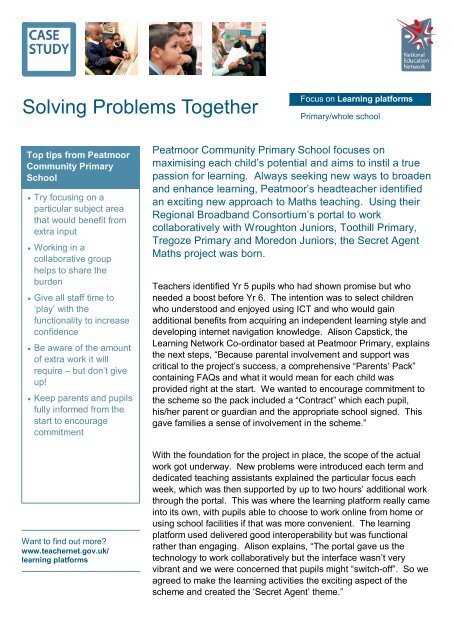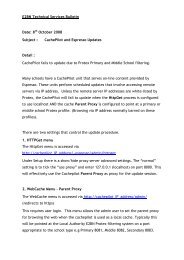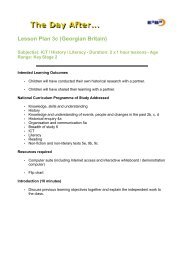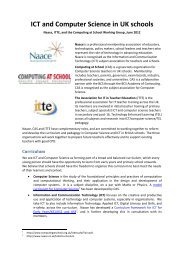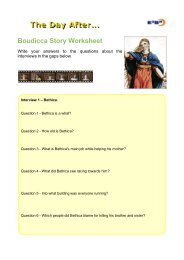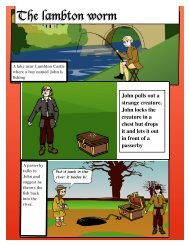Case Study: Solving Problems Together - E2BN
Case Study: Solving Problems Together - E2BN
Case Study: Solving Problems Together - E2BN
Create successful ePaper yourself
Turn your PDF publications into a flip-book with our unique Google optimized e-Paper software.
<strong>Solving</strong> <strong>Problems</strong> <strong>Together</strong><br />
Focus on Learning platforms<br />
Primary/whole school<br />
Top tips from Peatmoor<br />
Community Primary<br />
School<br />
· Try focusing on a<br />
particular subject area<br />
that would benefit from<br />
extra input<br />
· Working in a<br />
collaborative group<br />
helps to share the<br />
burden<br />
· Give all staff time to<br />
‘play’ with the<br />
functionality to increase<br />
confidence<br />
· Be aware of the amount<br />
of extra work it will<br />
require – but don’t give<br />
up!<br />
· Keep parents and pupils<br />
fully informed from the<br />
start to encourage<br />
commitment<br />
Want to find out more<br />
www.teachernet.gov.uk/<br />
learning platforms<br />
Peatmoor Community Primary School focuses on<br />
maximising each child’s potential and aims to instil a true<br />
passion for learning. Always seeking new ways to broaden<br />
and enhance learning, Peatmoor’s headteacher identified<br />
an exciting new approach to Maths teaching. Using their<br />
Regional Broadband Consortium’s portal to work<br />
collaboratively with Wroughton Juniors, Toothill Primary,<br />
Tregoze Primary and Moredon Juniors, the Secret Agent<br />
Maths project was born.<br />
Teachers identified Yr 5 pupils who had shown promise but who<br />
needed a boost before Yr 6. The intention was to select children<br />
who understood and enjoyed using ICT and who would gain<br />
additional benefits from acquiring an independent learning style and<br />
developing internet navigation knowledge. Alison Capstick, the<br />
Learning Network Coordinator based at Peatmoor Primary, explains<br />
the next steps, “Because parental involvement and support was<br />
critical to the project’s success, a comprehensive “Parents’ Pack”<br />
containing FAQs and what it would mean for each child was<br />
provided right at the start. We wanted to encourage commitment to<br />
the scheme so the pack included a “Contract” which each pupil,<br />
his/her parent or guardian and the appropriate school signed. This<br />
gave families a sense of involvement in the scheme.”<br />
With the foundation for the project in place, the scope of the actual<br />
work got underway. New problems were introduced each term and<br />
dedicated teaching assistants explained the particular focus each<br />
week, which was then supported by up to two hours’ additional work<br />
through the portal. This was where the learning platform really came<br />
into its own, with pupils able to choose to work online from home or<br />
using school facilities if that was more convenient. The learning<br />
platform used delivered good interoperability but was functional<br />
rather than engaging. Alison explains, “The portal gave us the<br />
technology to work collaboratively but the interface wasn’t very<br />
vibrant and we were concerned that pupils might “switchoff”. So we<br />
agreed to make the learning activities the exciting aspect of the<br />
scheme and created the ‘Secret Agent’ theme.”
Focus on Learning platforms<br />
Primary/whole school<br />
“Overall the biggest ‘pro’<br />
in favour of this way of<br />
teaching and learning is<br />
that it works!”<br />
Alison Capstick, Learning<br />
Network Coordinator, Peatmoor<br />
Primary<br />
“Each pupil became a secret agent receiving a new assignment each<br />
week. A host of colourful characters were created, including Prof and<br />
Secret Agent X, to help them as they worked towards completing the<br />
ultimate goal of their mission. The theme ensured that the activities<br />
were engaging and rewarding for the pupils, while delivering effective<br />
learning outcomes under the control and guidance of teachers.”<br />
The proof of the pupils’ enthusiasm for this more independent and<br />
collaborative way of learning appears to be confirmed by the retention<br />
rate. Of the 50 pupils who started the programme, only two failed to<br />
complete the full year. Alison explains, “While it is difficult to directly<br />
attribute improvement to the project, many of the pupils involved have<br />
demonstrated an increase in mathematical ability. At Peatmoor all<br />
but one of the pupils progressed based on their Yr 4 results and<br />
anecdotally both teachers and parents have remarked on pupils’<br />
increased confidence and more positive attitude to Maths.”<br />
The National Education Network<br />
provides schools with a secure<br />
network over which a range of<br />
quality broadband services and<br />
content are delivered consistently<br />
for learning. www.nen.gov.uk<br />
Alison summarises, “As with anything new, there have been<br />
challenges to overcome too. It has meant an increased workload but<br />
time and familiarity will ease this in the future. The technical issues of<br />
sharing resources across the network caused some problems early<br />
on, but these can be ironed out with the correct support, and coordinating<br />
people across five sites will always be a challenge!<br />
Overall, the biggest ‘pro’ in favour of this way of teaching is that it<br />
works! Pupils enjoy participating in something new, staff have<br />
acquired new IT skills, class based learning has been enhanced<br />
resulting in increased confidence and schools have worked<br />
collaboratively to share knowledge and expertise.” With a successful<br />
project under their belts, the schools involved are now all looking to<br />
the future to develop their use of learning platforms.


